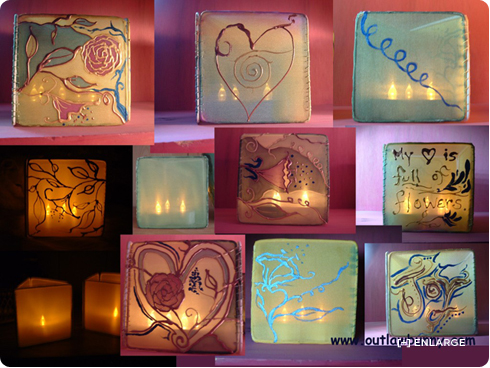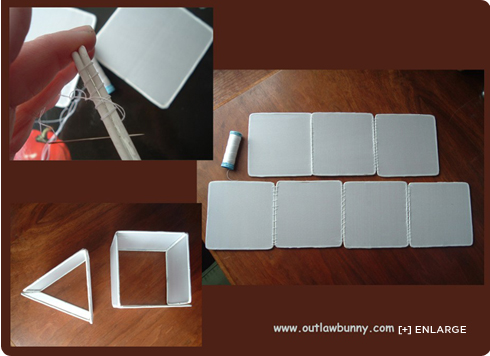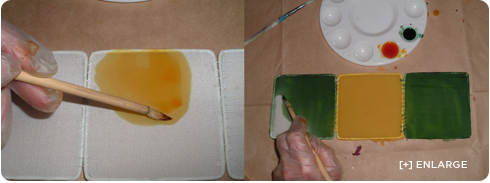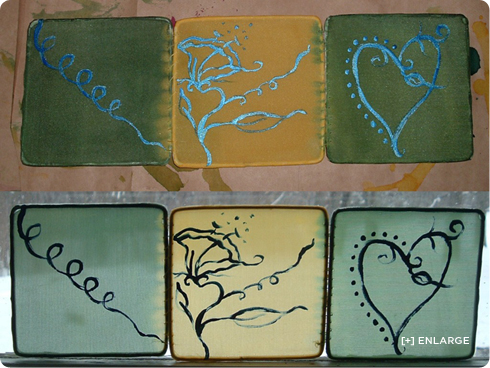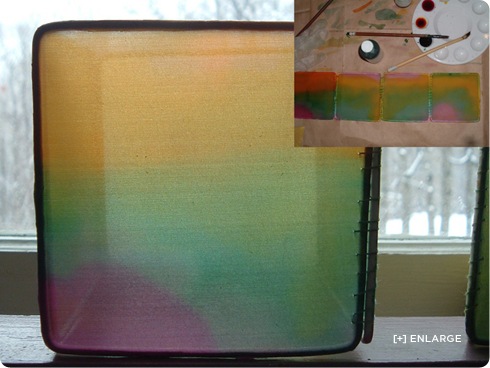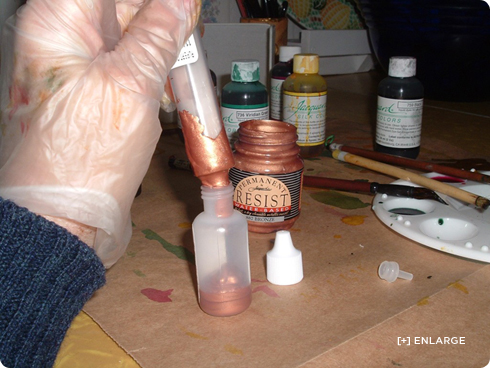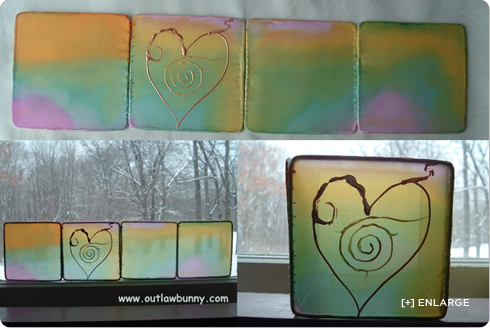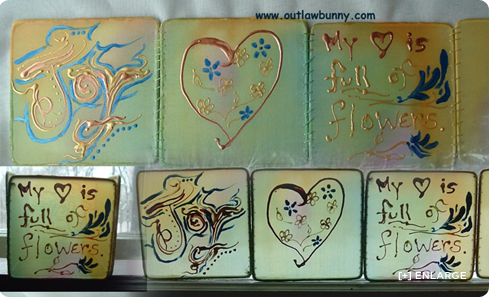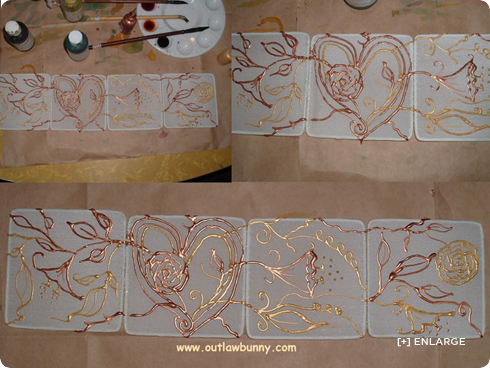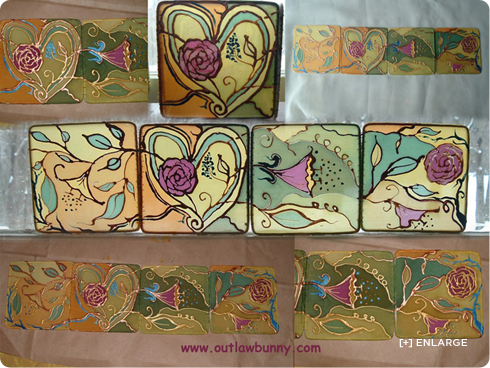
I love candle light and pretty candleholders, but my rambunctious kitty would set the house on fire. Elizabeth Buffington suggested I whipstitch 3" square silk "hoops" together to make a luminary with LED tea lights.
I got obsessed creating designs, so you have a range from which to choose. We'll start with drop-dead easy, and progress to more technical or time-consuming versions. And check out More Helpful Hints at the end.
Shopping list:
Let's get started!
Whipstitch four square 3" silk "hoops" together as shown in the photo below; note they're sewn with all their fronts on the same side. I used White Silk Sewing Thread because it would dye the same as the hoops' silk. Don't connect the end squares; the luminary will stand fine without that; and dyeing or painting panels would be hard were the ends joined. In the photo, also note that you can also make a three-sided luminary:
Trial and error showed me: 1) As I sew, I should keep checking that my stitches are neither too loose nor too tight. In other words, tight stitches make a stable, well-shaped cube but, if too tight, they do not allow right-angles to make a cube (a cube with no top or bottom, by the way). 2) I shouldn't insert the needle right up against the metal frame; but the distance between the frame and point of insertion needs to be minimal.
If you enjoy white silk's luminous simplicity, your work is done! Perfect for one quick and special lighting accent, or a batch of luminaries for an event. See the opening collages lower left-hand corner for these peaceful elegant cubes.
Simply dyeing the squares with Jacquard Green Label Silk Dyes (use a silk-painting brush) also looks great. Do all four (or three) panels the same color or each panel differently. Wear gloves to avoid stained hands. Applying dye:
Center of the opening collage, you can see the green and yellow luminary, green side showing.
If you want to take it a step further, let the dye dry, then draw on the front panel or as many panels as you want. I drew a fairly simple picture and, if you can only make an even simpler drawing, rock on! The most basic easy lines, like a spiral on just one of the squares, looks awesome! Simple drawing ideas: leaf; cute smiley sun. I used Lumiere Pearlescent Blue, which is thick, and I wanted some of its lines delicate, so I used a very fine brush. Here is the result (Taking candlelight pictures is difficult. So I photographed finished luminaries in my window, to help you better see what they can look like):
Another variation: Dilute the dyes for a colored wash. Dyes look much darker when wet, so don't dilute too much. I chose to blend three colors in each square, which has to be done before any of the three dry, to avoid watermarks.
If you want to be more elaborate, draw over the wash once it is dry. You can use Lumiere or Jacquard Permanent Water Based Resist. I applied resist using a resist applicator bottle with Tip #5. A syringe is an easy way to get resist into that little bottle. Otherwise, it can be messy and difficult. Cut off some of the syringe tip, or its opening will be too narrow, because resist is very thick.
I used both Gold and Bronze resist. Another finished luminary:
You could also write a word. I chose "joy." Simple letters looks great backlit by candles, but I love ornamentation. I also got carried away and wrote/designed a luminary picture-poem (a plain color panel is the back). This luminary has both resists and Lumiere:
If you prefer, paint on undyed silk, with Lumiere or resists. These lighting accents lend themselves to the simplest designs, but I got carried away again. My design is a heart growing flowers into the other panels:
Though the above works as a finished piece (check it out in the opening collage, middle and all the way left), I took it further. This final version is the most complex of these luminaries. Dye spreads every-which-way on silk unless resist lines contain it. Dharma Trading Company says about this use, "Of all the products Dharma carries resists are the most technically difficult to use." Drawing with resists in the above variations is good practice before using them to block spreading dye. The instructions in this blog can also really help.
After the dye dried, I finished with some Lumiere Pearlescent Blue:
More Helpful Hints:
- Do not block the LEDs from shining out through the silk. In other words, Lumiere and resists are opaque, so should be used sparsely.
- If you wash more than one color onto a square, they overlap to make new colors; either be knowledgeable about color mixing or enjoy surprises and be willing to build on them.
- I used the same colors for all the luminaries, because I wanted a set. Color repetition meant I could have different designs without sacrificing an overall matched look.
- But just one luminary provides a lovely accent on a fireplace mantel, bureau, or sacred space.
- Put one or several LED tea lights in a luminary. (I bought my lights, three for a dollar, at a Dollar Tree.) I suggest you do not use real candles, I think they would set the silk on fire.
- These dyes and paints are not set, so do not get your luminaries wet.
- You can only win with this project: Whatever your level or type of skill, there are ways to apply it, and even the basic version alone is easy and stylish.
This tutorial was provided by Francesca De Grandis, from her site Outlaw Bunny.








